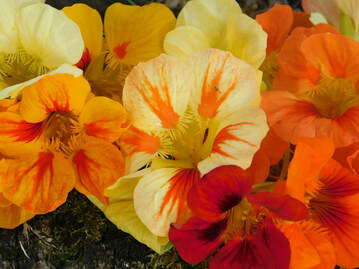 "Nothing is older, better known, or more disregarded", writes Professor James Rhoads, "than the proverb that tells us of a weakness peculiar to man, which induces him to despise what he can have with little trouble or expense, no matter how beautiful it may be. This moralizing has little to do with flowers, but some of the prettiest and most neglected of flowers have something to do with it—for they caused it". And the particular flower he had in mind was the pretty Garden Nasturtium (Tropaeolum majus). True, it seems to have held its own in our gardens, but perhaps it has not been quite appreciated as it should be! Interestingly enough, there are very few poetical associations with this flower, and I am not the first to notice this. In her book Flora Domestica (1823), Elizabeth Kent says that "notwithstanding the glowing and sunny beauty of this well-known flower," it seemed to have been "almost overlooked by those immortal bestowers of immortality, the poets". 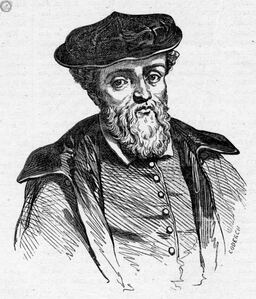 Nicolas Monardes (1493-1588) Nicolas Monardes (1493-1588) The Nasturtium is a native of South America and was brought back to Spain by the Spanish physician and botanist Nicolas Monardes (famous for his work, Joyfull News Out of the New Found World, and after whom the genus Monarda is named). From there it seems to have been introduced to France, and later to England. Several 19th century writers give the year of its introduction to England as 1686, but Gerard writes in 1596 that he had received seeds for "this rare and faire plant" from a friend in Paris. It was first known as Indian Cress, possibly because the Americas were still considered to be a part of the Indies at the time, and because the leaves and flowers were used in salads like Cress. Another old English name for this flower is Lark's Heel. This name must have come somewhat later, as Gerard does not mention it as a name but simply compares it to the Field Larkspur (Consolida regalis), because "unto the backe-part [of the flower] doth hang a taile or spurre". But in Shakespeare's The Two Noble Kinsmen, mention is made in the opening song of "Lark's-heels trim". According to the notes I have found in the back of an edition published in 1906, this is believed to be the Nasturtium, not the Larkspur, as might be supposed! I have not been able to find out when it came to be called Nasturtium, since it is not very closely related to the true Nasturtium genus (indeed, at least one 19th century writer calls it a foolish name!) but I did learn that the word is derived from the Latin naris, a nose, and torquere, to twist, a possible reference to the rather bitter smell! The genus name Tropaeolum is derived from the Greek Tropaion, a trophy, and was given by Linnaeus, who, I am just finding out, had quite a lively fancy! It is said that the leaves, resembling shields, and flowers like blood-stained helmets, reminded him of an ancient Roman custom in which the Romans set up a trophy pole where they hung the armor and weapons of their vanquished enemies. 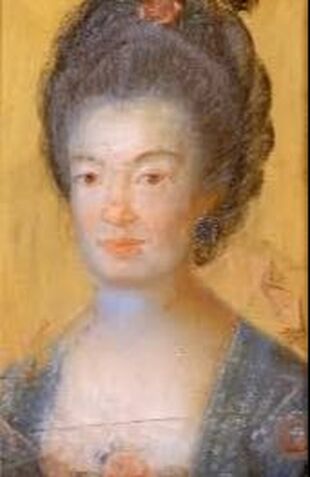 Elisabeth Christina von Linne Elisabeth Christina von Linne About 1762, at the age of 19, Linnaeus' oldest daughter Elisabeth Christina noticed something unusual about the Nasturium flowers in her father's garden at Hammarby. Walking in the garden at twilight, she observed that the bright reddish flowers seemed to be giving off flashes of light at certain intervals. She reported this to her father, and later even published a paper entitled Om Indiska Krassens Blickande (Concerning the Flickering of the Indian Crass), in which she questioned whether the flashing came from the flowers themselves, or were rather an illusion of the eye. Her discovery attracted the notice of several noted scientists of the day, who attributed it to different causes, such as electricity, phosphorescence, or simply a wild imagination! There is a very interesting article published in Paxton's Magazine of Botany in 1836 by a Mr. J. R. Trimmer, considering all the different possible causes. He writes that this phenomenon is not "more wonderful than that the electric eel and torpedo should give voluntary shocks of electricity; and in this plant perhaps, as in those animals, it may be a mode of defense, by which it harasses or destroys the night-flying insects which infest it, and probably it may emit the same sparks during the day, which must be then invisible. This curious subject deserves further investigation. The ceasing to shine of this plant after twilight might induce one to conceive that it absorbed and emitted light like the Bolognian Phosphorus, or calcined oyster shell. The light of the evening, at the same distance from noon, is much greater, as I have repeatedly observed, than the light of the morning; this is owing, as I suppose, to the phosphorescent quality of almost all bodies in a greater or less degree, which thus absorb light during the sunshine, and continue to emit it again for some time afterwards, though not in such quantity as to produce apparent scintillations.” He goes on to quote Erasmus Darwin, who writes: “In Sweden a very curious phenomenon has been observed on certain flowers, by M. Haggren, Lecturer on Natural History. One evening he perceived a faint flash of light repeatedly dart from a marigold; surprised at such an uncommon appearance, he resolved to examine it with attention, and to be assured that it was no deception of the eye, he placed a man near him, with orders to make a signal at the moment when he observed the light. They both saw it constantly at the same moment. The light was most brilliant in marigolds of an orange colour, but scarcely visible in pale ones." Mr. Trimmer claims to have "often observed the curious circumstance of the flashing of flowers, with out being at all able to ascertain its cause. Sometimes I have been almost led to suppose it to be an optical deception, occasioned by an impression made on the eye by the bright colour of the flowers from which the coruscations seemed to proceed. But at times I have seen the flashes of light so vivid and plain, and extend to so great a distance, that it is impossible for me longer to entertain that opinion; besides, too, I have seen the flashes proceed from pale-coloured and even white flowers, which would not make that impression on the eye. On the whole, I am much inclined to believe it to be electric, particularly from a circumstance which occurred a few years ago. In walking in my garden in the evening, in which was a considerable quantity of the Nasturtium in bloom, not at all thinking of the flashing of plants, I was struck by the very vivid flashes that proceeded from them, the scintillations were the most brilliant that I had ever observed, and at the same time the sky was overcast with a thunder cloud; directed by this circumstance, I have on several occasions looked for the flashes, when in the evening there has appeared electric clouds collecting, and have always found them, at that time, most to abound, and to be most brilliant." 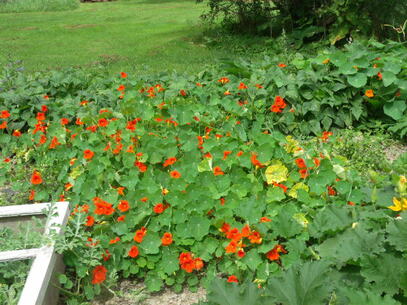 The poet-scientist Goethe seems to have been the first to realize that this unusual flashing, which had now been observed in other brightly colored flowers, including the Calendula, African Marigold, and Sunflower, was indeed an optical illusion caused by the brilliant flowers amongst the leaves in certain light conditions, pointing out that this flashing was only seen in a flower which comes sideways into the field of vision. Professor F. A. W. Thomas confirmed this in 1914. "It is perceived", he says, "in twilight, which makes red brighter and green duller than they appear in full daylight. As the image of the red flower moves from the peripheral part of the retina, where the rods are red-blind, to the fovea, the red is perceived somewhat more vividly than before, and this image coincides with the Purkinje after-image of the surroundings, giving the impression of a flash". This curious marvel is still known as the Elisabeth Linnaeus Phenomenon. There are even a few references to it in poetry, such as these beautiful lines from Samuel Taylor Coleridge... 'Tis said, in summer's evening hour I heartily agree with Elizabeth Kent, who says that surely this flower is as worthy of a poet's praise as so many others that have been immortalized..."singular leaves, fire-coloured flowers, a lady, sparks of light, and an evening,—what might not a poet make of all these?"
13 Comments
JanetLee
1/15/2019 09:43:03 am
Beautiful flower, interesting background.
Reply
Yes they are beautiful! The only thing I don't like about them is their smell but they more than make up for that. 😊 In my experience they are very carefree plants, but maybe there is something about your climate they don't like? I know they actually prefer poor, somewhat dry soils.
Reply
The flashing flowers phenomenon is very fascinating to me...I haven't seen it either, but I'm definitely planning to spend more time around them in the evenings next summer. 😊
Reply
I actually thought of you while I was posting this because I remembered some of the pretty nasturtium vases you had shared with us on IAVOM! 😊 Thank you for sharing the link in your post! I had a good time going back and reading some of your posts on this flower. I loved the nasturtium fairy, and that you mentioned that they are also called Lark's Heel. I forgot to mention that in my post, but Gerard compares it to Consolida regalis, which he says was called "Larke's heele" (now Field Larkspur).
Reply
It is done! 😊 You can find the added notes in the 3rd paragraph. Thanks to you, I did more research on the name and found out a few more interesting things, including a possible reference in Shakespeare! Now I'm curious, is Lark's Heel still a commonly used name in England? Just wondering, as I have never heard it called that here, yet I found it listed in an American dictionary as late as 1895! I love Nasturtiums, though they struggle a bit when I put them in my containers. They live through the season, but they are not especially robust or floriferous. Nothing like the glorious Nasturtiums I've seen in California. Still, those colors!!! Especially 'Empress of India'. Even a feeble Nasturtium is worth quite a lot.
Reply
'Empress of India' is another beautiful one which I have only seen in pictures! I have never had much luck with them in containers either, come to think of it! I love to plant them in the vegetable garden where they trail between the rows. By August most of the ground is covered with them! They like to self-sow too, so nowadays I don't really even have to plant them!
Reply
Leave a Reply. |
AuthorI am a passionate gardener and seed-saver, who also enjoys playing the violin and accordion, running, spending time with my 4 golden retrievers, keeping chickens, photography, and reading. Archives
March 2019
|
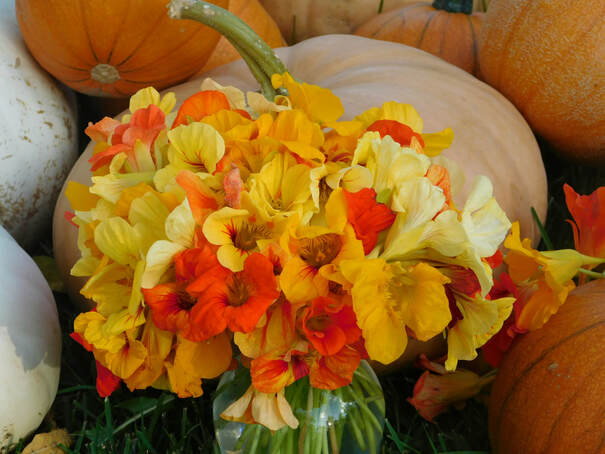

 RSS Feed
RSS Feed
